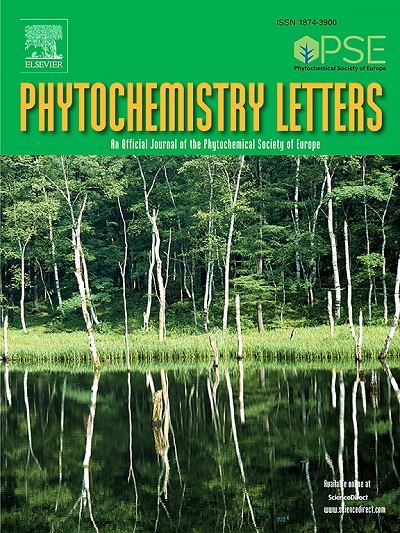从 Apiospora xenocordella 培养基中提取的两种新化合物及其对 TNF-α 诱导的 ROS 生成和 MMP-1 分泌的抑制作用
IF 1.3
4区 生物学
Q4 CHEMISTRY, MEDICINAL
引用次数: 0
摘要
从 Apiospora xenocordella 培养基的乙酸乙酯提取物中分离出了一种新的细胞分裂素衍生物(1)和一种新的酚类化合物(2)以及细胞分裂素 D(3)。分离工作流程以基于分子网络的去复制策略为指导。利用 MS 和 NMR 光谱技术确定了新化合物的化学结构,并通过改进的 Mosher 法和电子圆二色性量子化学计算确定了其绝对构型。紫外线辐射会激活促炎细胞因子,如 TNF-α,而 TNF-α 是通过产生 ROS 和分泌 MMP-1 导致皮肤老化的主要因素。细胞分裂素 D (3) 对 TNF-α 诱导的 ROS 和 MMP-1 有抑制作用。紫外线辐射会激活包括 TNF-α 在内的促炎细胞因子,而 TNF-α 是通过活性氧(ROS)生成和基质金属蛋白酶-1(MMP-1)分泌导致皮肤老化的主要因素。Cytosporin D (3) 对 TNF-α 诱导的 ROS 和 MMP-1 有适度的抑制作用。该化合物通过计算与 MMP-1 的活性位点对接(-5.9 kcal/mol)。化合物 1 虽然因数量有限而未进行测试,但其对接模拟结果(-6.0 kcal/mol)与细胞孢子素 D(3)相似,表明其具有潜在活性。本文章由计算机程序翻译,如有差异,请以英文原文为准。
Two new compounds from Apiospora xenocordella culture medium and their inhibitory effects on TNF-α-induced ROS generation and MMP-1 secretion
A new cytosporin derivative (1) and a new phenolic compound (2), together with cytosporin D (3), were isolated from an EtOAc extract of Apiospora xenocordella culture medium. The isolation workflow was guided by a Molecular Networking-based dereplication strategy. The chemical structures of the new compounds were determined by using MS and NMR spectroscopic techniques, and the absolute configurations were established by the modified Mosher’s method and quantum chemical calculation of electronic circular dichroism. UV radiation activates pro-inflammatory cytokines, such as TNF-α, a major contributor to skin aging through ROS generation and MMP-1 secretion. Cytosporin D (3) exhibited the inhibition of TNF-α-induced ROS and MMP-1. UV radiation activates pro-inflammatory cytokines including TNF-α which is a major contributor to skin aging through reactive oxygen species (ROS) generation and matrix metalloproteinase-1 (MMP-1) secretion. Cytosporin D (3) exhibited moderate inhibition against TNF-α-induced ROS and MMP-1. This compound docked computationally into the active site of MMP-1 (−5.9 kcal/mol). Compound 1, though not tested due to limited quantity, showed a docking simulation result (−6.0 kcal/mol) similar to cytosporin D (3), indicating potential activity.
求助全文
通过发布文献求助,成功后即可免费获取论文全文。
去求助
来源期刊

Phytochemistry Letters
生物-生化与分子生物学
CiteScore
3.00
自引率
11.80%
发文量
190
审稿时长
34 days
期刊介绍:
Phytochemistry Letters invites rapid communications on all aspects of natural product research including:
• Structural elucidation of natural products
• Analytical evaluation of herbal medicines
• Clinical efficacy, safety and pharmacovigilance of herbal medicines
• Natural product biosynthesis
• Natural product synthesis and chemical modification
• Natural product metabolism
• Chemical ecology
• Biotechnology
• Bioassay-guided isolation
• Pharmacognosy
• Pharmacology of natural products
• Metabolomics
• Ethnobotany and traditional usage
• Genetics of natural products
Manuscripts that detail the isolation of just one new compound are not substantial enough to be sent out of review and are out of scope. Furthermore, where pharmacology has been performed on one new compound to increase the amount of novel data, the pharmacology must be substantial and/or related to the medicinal use of the producing organism.
 求助内容:
求助内容: 应助结果提醒方式:
应助结果提醒方式:


